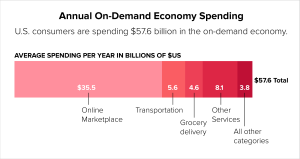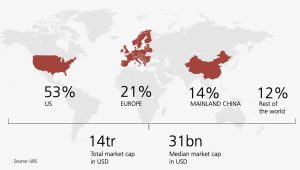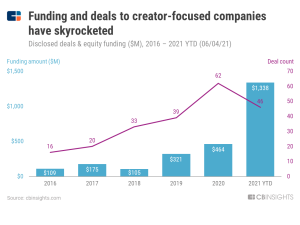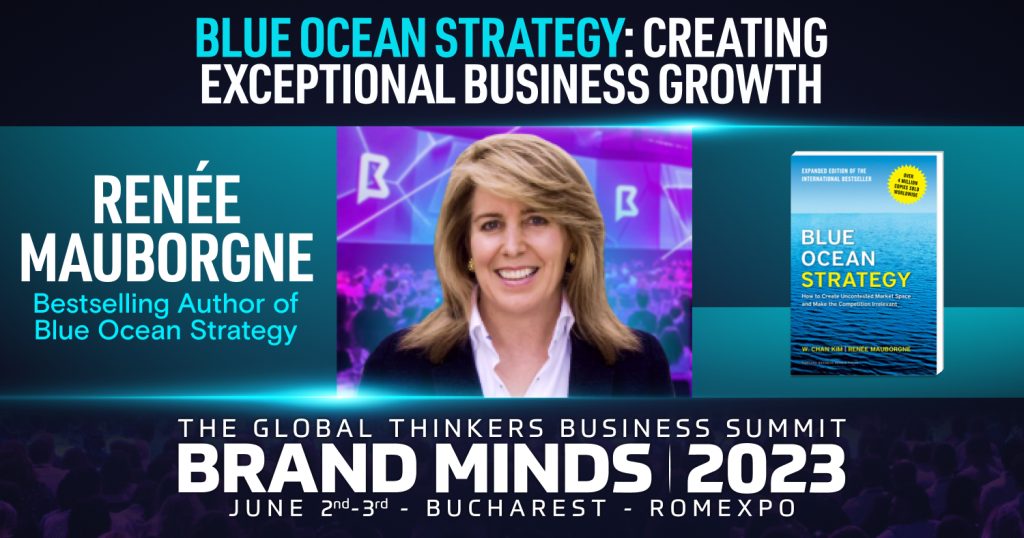3 rising global economies: on-demand, subscription and creator
What is the on-demand economy?
The on-demand economy is an ecosystem of consumers looking for immediate delivery of goods and services and companies fulfilling said demand via digital platforms.
Companies participating in the on-demand economy are digital-native and brick-and-mortar.

Image source: Pixelgrafia
Digital native companies are built around their digital platforms. The best examples are Uber, Airbnb and Glovo.
Brick-and-mortar companies like global tour operators, airlines and restaurants, which used to have a traditional “come to me” approach, changed their business model to include the “we come to you” approach specific to the on-demand economy.
The driving forces behind the rapid development of the on-demand economy are the smartphone and consumers’ search for convenience.
Why put in the effort to go out and get this product when you can click a button and have it delivered to your doorstep? It disrupted the way many companies did business and those that didn’t adapt, failed.

This is the case of Thomas Cook, the world’s longest-running travel agency.
Founded in 1845, the global leisure travel provider was operating in 17 countries, owned a fleet of aircraft and operated thousands of hotels around the world.
In 2019, the news of Thomas Cook’s bankruptcy came as a complete shock. Two of the reasons for the agency’s failure was 1) missing the opportunity to include the Millennials among its customers and 2) changing its business model too late.
Two years before the company’s downfall, Thomas Cook travel agents were still selling travel packages in high-street stores, while online sales in the UK were growing by as much as 30%.
While city breaks became in high demand among a new category of buyers with spending power and looking to travel the world, i.e. Millennials, Thomas Cook was stuck selling holiday packages to their parents and grandparents.
How big is the on-demand economy?
The on-demand economy is estimated to rise to 335 billion dollars by 2025, according to a PwC report.
What is the subscription economy?
The subscription economy describes a new business landscape in which traditional pay-per-product (or service) companies are moving toward subscription-based business models with customers paying a recurring price at regular intervals for access to a product or a service.

Image source: 2021 UBS report
The term subscription economy was coined by Zuora, an enterprise software company that creates and provides software for businesses to launch and manage their subscription-based services.
The subscription economy is not new. The first companies to participate in the subscription economy were news stations and other publishers whose readers paid a monthly fee to have newspapers and magazines delivered to their door.
More recently, other companies have entered this economy, some having to adapt to the global change due to the pandemic:
- Dog food companies: instead of going to the pet shop to buy food for their pets, pet owners can now subscribe to have their pet’s food delivered (PetPlate, Jinx, Crafted Kibble);
- Beauty care and makeup companies: the trip to your favourite beauty care and makeup shop has now been replaced with a subscription box to your favourite brand (GlossyBox, BoxyCharm, Birchbox);
- Meal plan suppliers: looking to eat healthily but don’t want to prepare the recipes? You can now subscribe to a meal plan of your choice and have it delivered every day (Pasta Evangelists, Raw Generation, Hello Fresh)
- Prescription drugs.
How big is the global subscription economy?
The global subscription economy is estimated to reach 14 trillion dollars in the near future, as detailed in a UBS report.
What is the passion/creator economy?
The passion economy is an ecosystem comprised of three elements:
- the creators who find, develop and sell products or services that make them unique;
- the market ie the people buying whatever products or services the creators offer;
- the digital platforms that enable the connection between creators and the market.

Image source: CBInsights
What are the new digital platforms that enable the creators in the passion economy and help them connect with a niche audience and scale their business?
Here are a few examples:
- Teachable, Podia and Thinkific are online course platforms allowing experts to monetize their knowledge;
- Mighty Networks is a platform helping creators build a business of their courses by tapping into the power of community (read more about Mighty Networks);
- Patreon and Buy Me A Coffee allow podcasters, video creators, and artists to earn a living from fans’ membership payments;
- VIPKid and Outschool allow people to earn a living from teaching;
- Substack allows writers to be paid directly by readers. In November 2021, the platform announced that it had more than 1 million paying subscribers. Bestselling authors Salman Rushdie (The Satanic Verses) and Chuck Palahniuk (Fight Club) are among the most influential writers on the platform.
- Lately, TikTok, YouTube, Snapchat and LinkedIn have jumped into the creator economy.
TikTok established the Creator Fund with the value of $1B to provide its best and brightest with the opportunity to earn money with their creative talent.
Snapchat is willing to pay $1 million daily for good content from creators on its platform. Snapchatters are invited to submit their top snaps to Spotlight and if the snaps go viral, the company is paying the creators a lot of money. Snapchatter Cam Casey has been paid nearly $3 million by the company for content that went viral. Learn how the rest of the platforms are leveraging the content creator economy.
How big is the global creator economy?
The creator economy is currently estimated at 104 billion dollars and is projected to grow to over 200 billion dollars by 2026, according to CB Insights.
Looking to learn more about growing industries?
Subscribe to our newsletter!
13 business models to generate revenue
How businesses can generate revenue has changed a lot over the last decade. Choose the most appropriate business model for your company from these 13 business models updated for 2021.
1. Control and be rewarded from your own data business model
In exchange for convenience and a personalized experience, brands have been telling consumers to give away their personal data and relinquish any control over it.
We now know how brands used their consumers’ data and the damage they have caused.
Also, selling users’ personal data to third parties has been a huge source of revenue for these companies.
According to the latest PwC report, times are changing.
Consumers are demanding both a better, data-enabled experience and more flexibility and control over how their information is used.
In addition to this, consumers are starting to ask themselves: why should only companies profit from selling their data? They should take a piece of the pie as well.
Gener8 Ads is a web browser offering exactly that: it lets users control and earn from their data whilst browsing the web.
Gener8 Ads works with companies in the capacity of a media owner to do three things:
1. Provide premium media for them to reach a highly defined audience.
2. Use their proprietary first-party data to unveil actionable insights about their customers, eg. their purchase habits.
3. To promote their brands and drive action from their audience.
How does Gener8 Ads generate revenue?
Gener8 Ads gives 80% of the revenue back to the user and takes a 20% cut.
Users download the Gener8 Ads browser and choose to keep their data private or earn points any time their data is used. They can redeem these points for products, vouchers or donations to charity.
Watch Sam Jones, the company’s founder pitch Gener8 Ads on Dragon’s Den:
2. Empowering creators business model
What is the creator economy?
The creator economy has been growing exponentially in the past few years. It is estimated that more than 50 million people worldwide consider themselves to be creators.
Mighty Networks defines the creator economy as an economy built around highly motivated, creative, and skilled individuals that have started their own brand, business, or community utilizing a digital platform to share their work.
Not coincidentally, Mighty Networks is one of the platforms contributing to the creator economy. It is a community-focused platform that helps users build their businesses.
Mighty Networks offers users three plans they can choose from: the free plan, the business plan ($81/month) and the community plan ($23/month).
This is how users can drive business revenue depending on their chosen pricing plan:
- Charge for access to their membership site or group
- Charge for access to their online courses
- Becoming a Mighty Affiliate
3. Shopstreaming business model
Shopstreaming is the combination of live streaming, entertainment and shopping.
China is leading the shopstreaming market with 67 billion dollars in global sales for 2019 and an estimated 149 billion dollars for 2020.
If these stats show anything is that consumers want to buy from influencers during shopstreaming sessions.
It’s a business opportunity that saw various developers create digital platforms intended to transform the way to stream live events.
Livescale is one such developer. The company’s shopstreaming platform, LivescaleTV enables businesses to reach, engage, and monetize their audience, as well as understand the behaviours and interactions of their users.
L’Oréal Canada was the latest brand to use Livescale TV when they hosted a three-day shopping streaming festival.
Results:
- over 50% of product purchases from new customers,
- 300% higher conversion rate than the company’s website,
- 40% audience engagement.
4. Blockchain-as-a-service business model
According to recent reports, the global blockchain-as-a-service market size is expected to grow at an impressive compound annual growth rate of 62.73% to $52.5 billion by 2026.
Blockchain as a Service (BaaS) is a type of blockchain service offering that allows business customers to use cloud-based solutions to develop, host and adopt their own blockchain applications, smart contracts and other relevant functions on the blockchain.
The main drivers of the global Blockchain-as-a-Service market are:
- increasing awareness of the benefits provided by blockchain technology;
- need for security in transactions.
The top leaders operating in the Blockchain-as-a-Service (BaaS) market: Oracle, Microsoft, Accenture, Alibaba, IBM and Huawei.
5. Subscription business model
The subscription business model is a business model in which customers pay a recurring price at regular intervals for access to a product or a service.
The first companies to adopt the subscription business model were the news publishers whose readers paid a monthly fee to have newspapers and other magazines delivered to their door.
In more recent times, companies providing digital tools and platforms like Canva, Monday or Grammarly generate recurring revenue based on the subscription business model.
Other companies didn’t start as subscription-based businesses but recognized an unmet need for their products to be delivered on a monthly basis.
Customers opt for products to be delivered on a monthly basis because it’s convenient and saves them precious time.
Here are some examples of products delivered in subscription boxes; some also provide customization:
- Dog food subscription boxes (PetPlate, Jinx, Crafted Kibble)
- Beauty care and makeup subscription boxes (GlossyBox, BoxyCharm, Birchbox)
- Meal subscription boxes (Pasta Evangelists, Raw Generation, Hello Fresh)
6. Freemium business model
Freemium is a business model in which a company offers basic features to users at no cost and charges a premium for supplemental or advanced features.
It’s an appealing strategy for both companies and customers. Free is a powerful word in marketing because of its ability to instantly grab a customer’s attention. If basic free features are valuable to them, customers are more likely to pay for advanced or additional features.
When used correctly, the freemium business model can drive massive user adoption.
Dropbox, Zoom and Spotify are great examples of the freemium business model.
Dropbox has an annual revenue of $1.91 billion, Zoom – $2.6 billion and Spotify, $9.34 billion.
7. Dropshipping business model
The dropshipping business model is used in retail where the seller purchases the product from a third party (manufacturer or wholesaler) and has it shipped directly to the customer. The seller doesn’t hold the products in stock.
The main benefits of the dropshipping business model:
- Low investment
- Easy to start
- Perfect for beginner entrepreneurs
- Flexibility
- Remote work
- Easy to scale
- Wide selection of products
Among the top eCommerce platforms for dropshipping businesses are Amazon, Shopify, WooCommerce and Magento.
8. Drop-servicing business model
Drop servicing is a business model where your company sells other people’s services online.
Your company doesn’t perform the service, a third-party company performs the service.
9. Commission-based business model
The commission-based business model is a revenue model where a user is charged a fee for each transaction. The platform may charge either the seller or the buyer.
Examples of commission-based businesses: PayPal, Uber, Airbnb, Etsy, eBay.
10. Hidden revenue business model
If the service is free, you are the product, goes a very famous saying.
What it means is the service is not actually free. As the user, you pay for it, not with money, but with your personal data.
It’s the business model of digital giants like Google, Facebook, Instagram, Pinterest etc which collect users’ data and sell it to businesses for advertising purposes.
In 2020, Google generated almost $147 billion in revenue from the company’s ads business. Facebook generated close to $84.2 billion in ad revenues.
11. Razor and blade business model
The razor and blades business model is a business model in which one item is sold at a low price in order to increase sales of a complementary good, such as consumable supplies.
The best examples of companies generating revenues with this type of business model are suppliers of razors and blades (Gillette), printers and ink cartridges (Xerox), coffee makers and coffee pods/capsules (Nespresso), 3D printers and printing materials, game consoles and games.
12. Reverse razor and blade business model
The reverse razor and blade business model is a type of business model where the main product is sold at a premium price and the consumable, at a lower price.
Apple is the standard example of the reverse razor and blade business model. The main product, the iPhone, is sold at a premium price. Once the customer owns an iPhone, they have access to low-priced features like music on iTunes, movies or Mac OS and iWork free of charge.
13. Affiliate marketing business model
The affiliate marketing business model is a revenue model in which a company compensates third-party publishers to generate traffic or leads to the company’s products and services.
The publishers are paid in commission for every sale they make.
How does it work?
The affiliate shows a link for the product they are selling on their website or social media, customers click on the link which sends them to the store. If they purchase the product, the affiliate is paid a commission.
Two of the top-earning affiliate marketing platforms are Amazon Associates and Shopify Affiliate Program.
Join the Conversation
We’d love to hear what you have to say.
Get in touch with us on our LinkedIn Page, Facebook Page, Twitter or TikTok.

